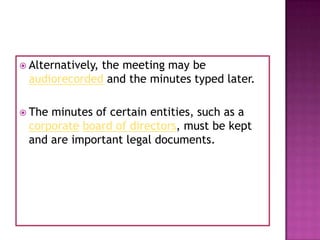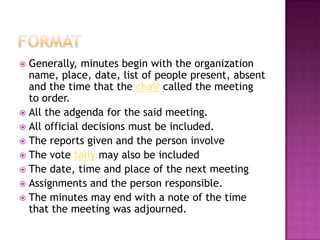Minutes Of A Meeting
- 2. Minutes also known as protocols, are the instant written record of a meeting or hearing. They often give an overview of the structure of the meeting. Theyare often created at the moment of the hearing by a typist or court recorder at the meeting.
- 3. Alternatively, the meeting may be audiorecorded and the minutes typed later. Theminutes of certain entities, such as a corporate board of directors, must be kept and are important legal documents.
- 4. Generally, minutes begin with the organization name, place, date, list of people present, absent and the time that the chair called the meeting to order. All the adgenda for the said meeting. All official decisions must be included. The reports given and the person involve The vote tally may also be included The date, time and place of the next meeting Assignments and the person responsible. The minutes may end with a note of the time that the meeting was adjourned.
- 5. Remember that meeting minutes are for future and outside readers as much as they are for the people present Typing meeting minutes on a laptop can make the process quicker and easier. Make a note of who is present. If necessary, pass around a sign-in sheet. Use the meeting agenda as an outline for the minutes. Details do not belong in meeting minutes. Do write down any motions and decisions made and the key findings of any committee reports.
- 6. Use bullet points to make the minutes easier to read. Each bullet statement should represent a different finding, discussion, or decision. Make a note of issues that were tabled until future meetings Transcribe or review minutes as soon as possible after the meeting, while your memory of what happened is still fresh. Before you submit the meeting minutes, proofread for typos and omissions.






